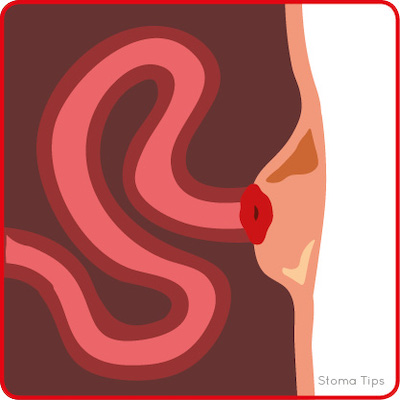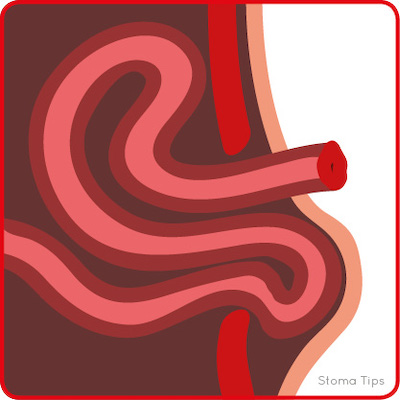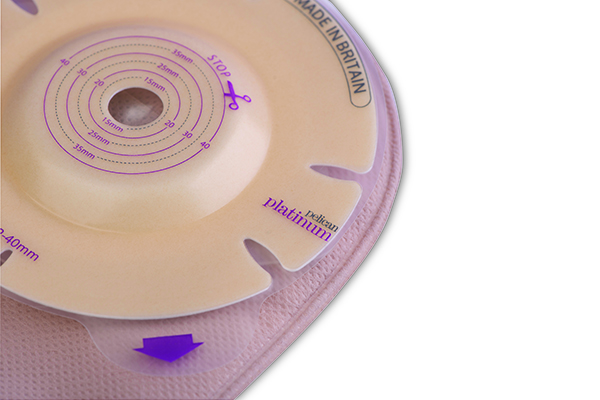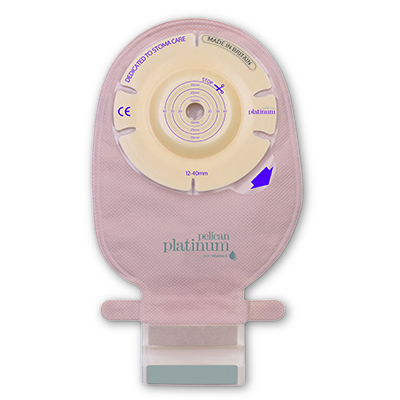Most people with a stoma will wear a pouch (also known as a bag or appliance). All pouches are made of a collection part (the bag) and an adhesive part (the baseplate, or sometimes faceplate, flange or wafer). The adhesive baseplate of a stoma pouch is usually flat in shape. However, some are shaped into a dome that faces into the body. The dome shape, known as convexity, applies pressure onto the peristomal skin, which allows the stoma to protrude further inside the pouch.
Understanding what convexity is and why, when and how it should be used will enable you to look after your stoma pouch better.
Is convexity for me?
Most pouches are flat because the area of skin around the stoma (the peristomal skin) to which they are designed to stick is, for many people, also flat. However, we don’t all have a flat tummy; there might be scars or creases, for example, which create an uneven skin surface that is difficult for a flat surface to stick to.
This can lead to an imperfect seal between the baseplate and peristomal skin, with small gaps that allow the stoma’s output to leak onto the skin. This can damage the skin, as well as potentially cause discomfort and odour, so stopping this occurring is vital. This is where convex pouches come in, as the shape and pressure can mould the skin into a better seal with the pouch.
Ideally, a stoma is spouted just above the surface of this skin, so that its contents can easily drop into the pouch. However, some stomas are level (flush) with or even retracted below the skin surface, which makes it more likely that the stoma output will leak under the baseplate. An opening of the stoma close to the skin surface also increases the chance of leaks. In these cases, a convex pouch may be useful, as the convex shape pushes down on the peristomal skin and allows the stoma to stick out further into the pouch.
The output of different stomas varies in consistency. More liquid output, such as from a urostomy or high-output ileostomy, is more likely to leak. A convex pouch can help avoid this.

Getting checked out
Convex pouches are only useful for certain people, and so should only be used after your stoma care nurse has had a chance to review your stoma and recommend whether you need one. There are many things they need to consider.
When you first go to see the stoma care nurse, you will be assessed, and it is likely that you will be asked some questions, such as what your stoma output looks like and if this has changed. It is also likely that the nurse will ask you to remove your pouch, so that your skin and stoma can be assessed.
There are no definite reasons never to use a convex pouch. Convex pouches are rarely used immediately after a stoma is formed, but they can be introduced soon after this if a problem occurs. However, convexity may not be appropriate for someone with a parastomal hernia, which is a bulge around the stoma caused by a piece of bowel protruding through the abdominal muscles. If this is the case, a stoma care nurse should be able to find an alternative solution.


Retraction (left) and parastomal hernia (right)
Choosing the right pouch
Once it is established that a convex pouch is necessary, it is important to determine the type of convexity. As there is so much choice and we are all different, sometimes a little trial and error is needed initially. A variety of convex pouches are available, at different depths and applying different amounts of pressure. Some are deep, others shallow; some are hard/firm, others soft. This can make choosing exactly which convex pouch is the best to use a bit of a challenge. Often, people start on soft, as opposed to hard/firm, convexity, but this will depend on the type of stoma that you have and what issues you are having with it.
All three types of stoma (colostomy, ileostomy and urostomy) have their own type of pouches, and these all come in one- or two-piece varieties. In one-piece (or integral) pouches, the bag and baseplate are joined. In two-piece pouches, the bag and baseplate are separate parts and are joined by clipping together or with a special adhesive. All of these pouch types are also available with convexity. As every stoma is unique, people with a stoma, with the help of a stoma care nurse, will need to find the one with the right combination of features for their needs.

Pelican Platinum convex pouch
On the lookout
A convex pouch is used in the same way as a pouch with a flat baseplate. When you start to use convex pouches, it is essential that you seek a review from a stoma care nurse. Even if you don’t have regular contact with the stoma nurse or if you move, you can ask your GP to refer you to your local hospital to see their stoma nurse.
Regardless of the type of pouch you use, it is good practice to check the skin at every change to make sure that you are not having any problems and see the stoma nurse if any concerning changes are detected.
When using convex stoma pouches, there are a number of issues that you should be on the lookout for in particular. There is a potential that the pressure exerted on the skin from the convexity can cause skin problems. If the skin where the dome pushes into your abdomen is red at removal, this is not a problem, but if the skin stays red or looks bruised, then you need to contact your nurse.
Likewise, if you use a seal or washer with the convexity, this may result in additional pressure and increase the risk of skin trauma.
The pouch can be secured with a thin, elasticated belt that attaches to the sides of the pouch and clips in place. If you use a belt with the convexity, this increases the pressure on the skin around the stoma, and, if it is too tight, it can cause trauma. In this case, the belt can be loosened, or padding can be used in areas that are uncomfortable.

Pelican Platinum drainable convex pouch
What users think
Some research has been undertaken to find out what people with a stoma think about convex pouches.1 Most people who used them reported that they felt secure, and many people also thought that the pouch could have stayed on longer without a leak, but they changed it as part of their regular routine. The majority of people taking part reported fewer leaks with convex pouches, which is the main reason for using them.
Reference
1. Hoeflok J, Salvadalena G, Pridham S et al. Use of convexity in ostomy care: results of an international consensus meeting. J Wound Ostomy Continence Nurs. 2017; 44(1):55–62
Summary
Most ostomates will not need to use a convex pouch, but if you are having an issue with leaks or sore skin, a stoma care nurse will let you know if convexity could resolve it. It is, however, important to make sure you check your skin at each pouch change and watch out for any additional issues caused by the extra pressure on your skin.
Jennie Burch is Head of Gastrointestinal Nurse Education at St Mark’s Hospital, London

